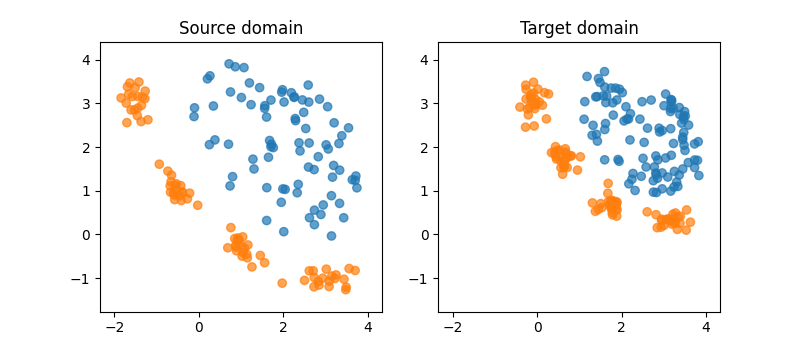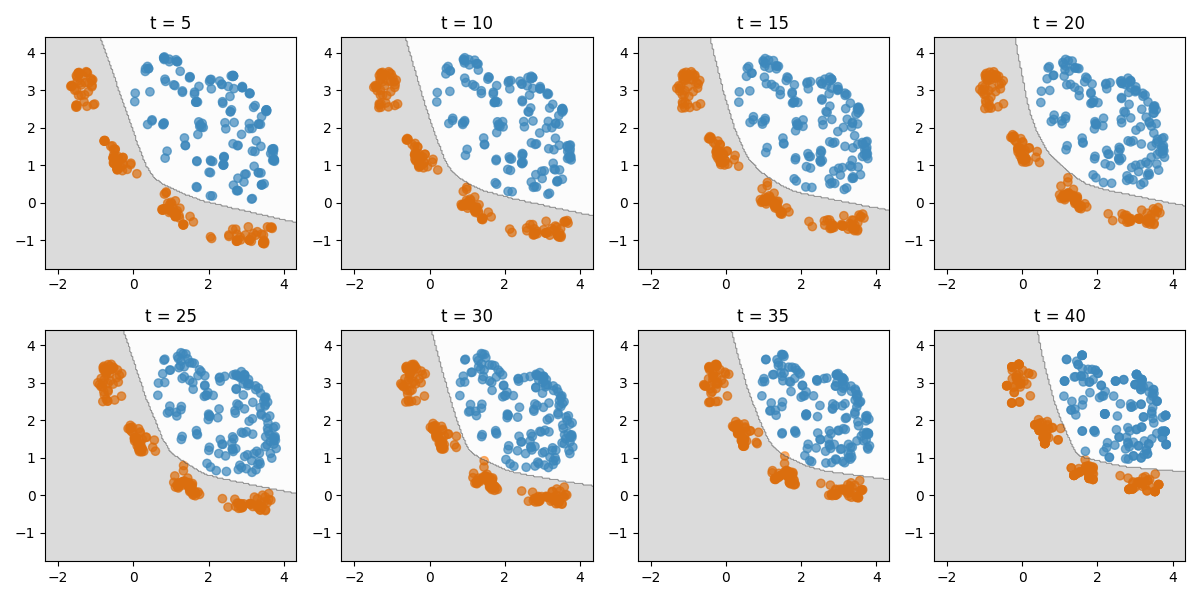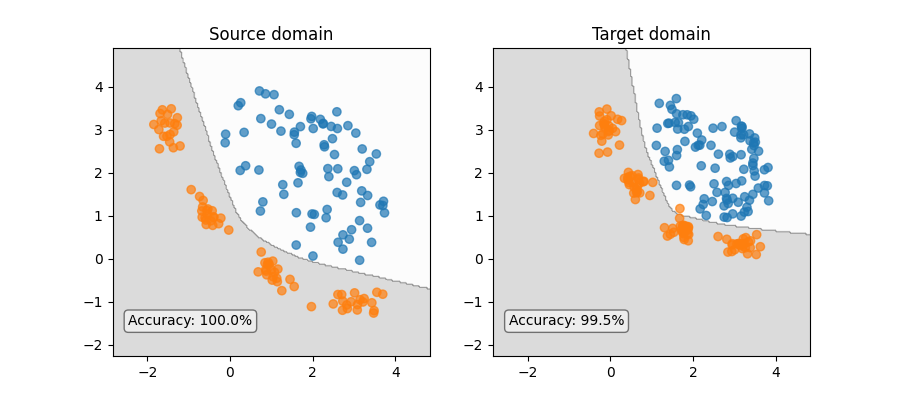Note
Go to the end to download the full example code.
Gradual Domain Adaptation Using Optimal Transport
This example illustrates the GOAT method from [38] on a simple classification task. However, the CNN is replaced with a MLP.
# Authors: Félix Lefebvre and Julie Alberge
#
# License: BSD 3-Clause
import matplotlib.pyplot as plt
from sklearn.inspection import DecisionBoundaryDisplay
from sklearn.neural_network import MLPClassifier
from skada import source_target_split
from skada._gradual_da import GradualEstimator
from skada.datasets import make_shifted_datasets
Generate conditional shift dataset
n, m = 20, 25 # number of source and target samples
X, y, sample_domain = make_shifted_datasets(
n_samples_source=n,
n_samples_target=m,
shift="conditional_shift",
noise=0.1,
random_state=42,
)
Plot source and target datasets
X_source, X_target, y_source, y_target = source_target_split(
X, y, sample_domain=sample_domain
)
lims = (min(X[:, 0]) - 0.5, max(X[:, 0]) + 0.5, min(X[:, 1]) - 0.5, max(X[:, 1]) + 0.5)
n_tot_source = X_source.shape[0]
n_tot_target = X_target.shape[0]
plt.figure(1, figsize=(8, 3.5))
plt.subplot(121)
plt.scatter(X_source[:, 0], X_source[:, 1], c=y_source, vmax=9, cmap="tab10", alpha=0.7)
plt.title("Source domain")
plt.axis(lims)
plt.subplot(122)
plt.scatter(X_target[:, 0], X_target[:, 1], c=y_target, vmax=9, cmap="tab10", alpha=0.7)
plt.title("Target domain")
plt.axis(lims)

(np.float64(-2.3407051687007465), np.float64(4.329230428885397), np.float64(-1.765584745112177), np.float64(4.406935559355198))
Fit Gradual Domain Adaptation
We use a MLP classifier as the base estimator (default parameters).
base_estimator = MLPClassifier(hidden_layer_sizes=(50, 50))
gradual_adapter = GradualEstimator(
n_steps=40, # number of adaptation steps
base_estimator=base_estimator,
advanced_ot_plan_sampling=True,
save_estimators=True,
save_intermediate_data=True,
)
gradual_adapter.fit(
X,
y,
sample_domain=sample_domain,
)
/home/circleci/.local/lib/python3.10/site-packages/sklearn/neural_network/_multilayer_perceptron.py:781: ConvergenceWarning: Stochastic Optimizer: Maximum iterations (200) reached and the optimization hasn't converged yet.
warnings.warn(
Check results
Compute accuracy on source and target with the initial estimator and the final estimator.
clfs = gradual_adapter.get_intermediate_estimators()
ACC_source_init = clfs[0].score(X_source, y_source)
ACC_target_init = clfs[0].score(X_target, y_target)
print(f"Initial accuracy on source domain: {ACC_source_init:.3f}")
print(f"Initial accuracy on target domain: {ACC_target_init:.3f}")
print("")
ACC_source = gradual_adapter.score(X_source, y_source)
ACC_target = gradual_adapter.score(X_target, y_target)
print(f"Final accuracy on source domain: {ACC_source:.3f}")
print(f"Final accuracy on target domain: {ACC_target:.3f}")
Initial accuracy on source domain: 1.000
Initial accuracy on target domain: 0.500
Final accuracy on source domain: 0.863
Final accuracy on target domain: 0.995
Inspect intermediate states
We can plot the intermediate datasets and decision boundaries.
intermediate_data = gradual_adapter.intermediate_data_
fig, axes = plt.subplots(2, 4, figsize=(12, 6))
axes = axes.ravel()
# Define which steps to plot
steps_to_plot = [5, 10, 15, 20, 25, 30, 35, 40]
for i, step in enumerate(steps_to_plot):
ax = axes[i]
X_step, y_step = intermediate_data[step - 1]
clf = clfs[step - 1]
ax.scatter(X_step[:, 0], X_step[:, 1], c=y_step, vmax=9, cmap="tab10", alpha=0.7)
DecisionBoundaryDisplay.from_estimator(
clf,
X,
response_method="predict",
cmap="gray_r",
alpha=0.15,
ax=ax,
grid_resolution=200,
)
ax.set_title(f"t = {step}")
ax.axis(lims)
plt.tight_layout()

Plot decision boundaries on source and target datasets
Now we can see how this gradual domain adaptation has changed the decision boundary between the source and target domains.
figure, axis = plt.subplots(1, 2, figsize=(9, 4))
cm = "gray_r"
DecisionBoundaryDisplay.from_estimator(
clfs[0],
X,
response_method="predict",
cmap=cm,
alpha=0.15,
ax=axis[0],
grid_resolution=200,
)
axis[0].scatter(
X_source[:, 0],
X_source[:, 1],
c=y_source,
vmax=9,
cmap="tab10",
alpha=0.7,
)
axis[0].set_title("Source domain")
DecisionBoundaryDisplay.from_estimator(
clfs[-1],
X,
response_method="predict",
cmap=cm,
alpha=0.15,
ax=axis[1],
grid_resolution=200,
)
axis[1].scatter(
X_target[:, 0],
X_target[:, 1],
c=y_target,
vmax=9,
cmap="tab10",
alpha=0.7,
)
axis[1].set_title("Target domain")
axis[0].text(
0.05,
0.1,
f"Accuracy: {clfs[0].score(X_source, y_source):.1%}",
transform=axis[0].transAxes,
ha="left",
bbox={"boxstyle": "round", "facecolor": "white", "alpha": 0.5},
)
axis[1].text(
0.05,
0.1,
f"Accuracy: {gradual_adapter.score(X_target, y_target):.1%}",
transform=axis[1].transAxes,
ha="left",
bbox={"boxstyle": "round", "facecolor": "white", "alpha": 0.5},
)
plt.show()

Total running time of the script: (0 minutes 12.127 seconds)